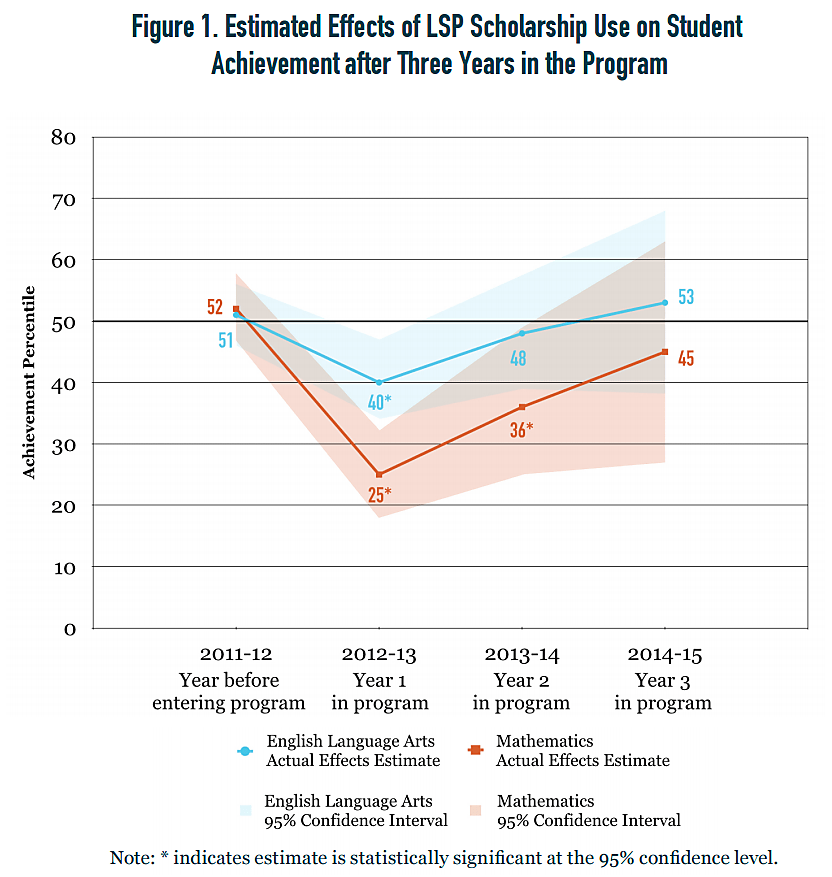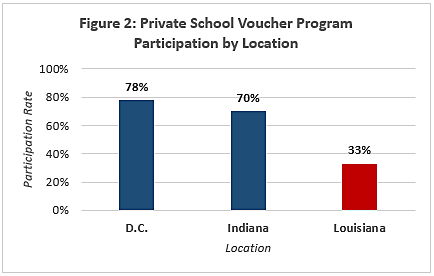My colleagues from the School Choice Demonstration Project and I just released the official third year reports on the Louisiana Scholarship Program (LSP). In addition to the experimental study on student test scores, my coauthors and I released a descriptive analysis of the types of private schools that chose to participate in the voucher program.
Positive Test Score Trend
The main report indicates that the LSP had negative impacts on student math test scores for the first two years of the program. Nonetheless, the program did not have any statistically significant impacts on student achievement by the end of year three. These results can be found in Figure 1 (from the report) below:
Source: Mills & Wolf (2017). “How Has the Louisiana Scholarship Program Affected Students? A Comprehensive Summary of Effects After Three Years.” School Choice Demonstration Project, Department of Education Reform, University of Arkansas.
This upward trend is not unusual. The recent meta‐analysis of 19 experimental voucher studies shows that private school choice programs are better at shaping test scores after a few years. This is likely because children need to adjust to their new educational settings and private institutions must respond to the environmental shift in the market for schooling.
The positive test score trend was also found in the Indiana study, and can be interpreted in two different ways:
- Private schools in voucher programs adjust and improve after a few years of participation.
- The incentive structure for private schools shifts from a focus on character education towards a focus on test scores since the state uses test scores as its preferred educational accountability measure.
Obviously, the second explanation is less optimistic since test scores do not necessarily convert to the long‐run outcomes that we actually care about.
Regulation Reduces School Quality
In the final report, we examine the difference in the types of schools that decide to participate in the DC, Indiana, and Louisiana voucher programs. As shown in Figure 2 below, we find that only a third of the private schools in Louisiana decide to participate in their program, while between 70–78% participate in DC and Indiana.
This is likely because the LSP has the strongest regulatory environment and, therefore, the greatest costs associated with participation. Private schools participating in the program must serve the most disadvantaged students, use the state standardized test, prohibit parental copay, report finances to the government, and surrender their admissions process over to the state.
We find that the schools that are willing to put up with all of the additional costs are the ones most desperate for funding. Using enrollment, tuition, and revenue levels as proxies, we find that lower quality institutions choose to participate in the LSP. Consequently, the LSP experiment can only measure the effects of being randomly assigned to one of the lower‐quality private schools in the state.
Of course, decision‐makers impose regulations on private schools in an effort to make it impossible for disadvantaged families to make bad choices. However, the very act of attempting to control quality ironically leads to a reduction in the quality of educational options available to children in need. Instead, policy‐makers ought to be more confident in the decision‐making abilities of the people most interested in the educational success of their children: parents.


